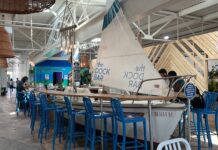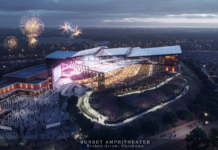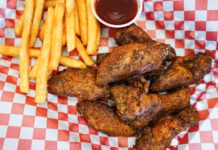On May 25, 2011, the Oklahoma City Thunder failed in its attempt to become the youngest NBA team to ever win an NBA championship. In fact, the team failed to even make the finals, losing four games and winning only one in the best of seven Western Conference finals to the Dallas Mavericks, who would go on to defeat the Miami Heat in the finals and become champions.
The loss that night was especially heartbreaking considering that for the second consecutive game, the precocious Thunder let a comfortable lead slip away in the final moments, allowing the more seasoned Mavericks to work their way back to steal victory and the conference title. It was the sort of defeat that might lead fans of some teams to grumble and moan. But when the team flight landed at Will Rogers World Airport in the early morning hours following the game in Dallas, Thunder players and staff were greeted by more than 500 fans and loving cheers of appreciation. Win or lose, Oklahoma City, and the entire state of Oklahoma, love their Thunder.
Thunder Up
Even after a loss so deflating, it’s easy to understand why the fans embrace this team. Small forward Kevin Durant, a three-time All Star and MVP of this season’s game, has led the league in scoring the past two seasons and is widely considered among the top two or three players on the planet. Point guard Russell Westbrook has established himself as one of the top players at his position in the league, as well as one of the most clutch performers. Sixth man and southpaw James Harden keeps opponents off-balance with his combination of awkward moves and ridiculously awesome and widely envied beard.
Throw in the hulking and intimidating Kendrick Perkins, shot-blocking specialist Serge Ibaka, blue collar veteran Nick Collison and a supporting cast of young and talented players that forms one of the league’s deepest and most effective benches and you have the recipe for long-term success. But the Thunder, now in its fourth season in Oklahoma City, isn’t far removed from the days when making the playoffs and competing for championships seemed like pipe dreams.
"Our first year here when we were struggling we had great crowds, and the players really appreciate that.”
“Ask our players what their favorite moment in relation to our fans is, and you probably expect to hear something about winning that first playoff game or first conference finals game,” says Thunder general manager Sam Presti. “But a lot of them will say it was the support we received in 2008, when we were struggling.”
Collison and Durant are the only players who were with the team when it was still located in Seattle. The final year the team played as the Seattle Sonics it was ranked No. 28 in the league for home game attendance. Since relocating to Oklahoma City the average ranking has been 13.
“We get really great fan support here, consistent fan support,” says Collison. “We can be playing against a non-playoff team and we’ll have a good crowd. Our first year here when we were struggling we had great crowds, and the players really appreciate that.”
The Mayor Who Wouldn’t Go Away
The residents of Oklahoma City got their first taste of NBA action in 2005 when the New Orleans Hornets were seeking a refuge following the devastation of Hurricane Katrina. In the aftermath of the disaster, the team needed a city with an arena to serve as their home court. Potential suitors to host the team were numerous, including Kansas City and San Diego, two cities that had previously had their own franchises and were eager to return to the NBA fold. Oklahoma City may have seemed an unlikely destination to most, but because of a series of meetings that took place in early 2005, NBA commissioner David Stern was well aware of city’s viability as a candidate.
“What ended up being the most critical moment was Mayor (Mick) Cornett going unsolicited to New York to meet with David Stern,” says David Holt. “He let Stern know that there was an infrastructure already in place. When the Hornets were displaced, their owner George Shinn asked, ‘Do they even have an arena?,’ and Stern already knew that they did. And the reason he knew was because of those meetings.”
Holt, Cornett’s former chief of staff and author of Big League City: Oklahoma City’s Rise to the NBA, cites the passage of the Metropolitan Area Projects (MAPS) program by Oklahoma City voters in 1993 as the first in a series of key moments that brought the NBA to the city. MAPS was an urban renewal program paid for by a temporary one cent sales tax that provided funding for construction and improvements of several downtown facilities, including the Bricktown Ballpark and the Ford Center.
“That was one thing that made Oklahoma City so attractive,” says Holt. “There was an arena that was already paid for with the potential for naming rights.”
By late September 2005 the league announced that the Hornets would temporarily relocate to Oklahoma City. Fan reaction was immediate and enthusiastic. The team that had played the previous season in front of the smallest crowds in the league was suddenly playing to a raucous and often sold-out arena.
“Everyone in the league was aware of the crowds,” remembers Presti, then assistant general manager for the San Antonio Spurs. “One of the things that stood out to me was the compassion the city showed to the people of New Orleans.”
Stern in particular noticed the crowds, and the enthusiasm with which the city had embraced the NBA. “The mayor who wouldn’t go away,” as he had previously dubbed Cornett, had been correct: Oklahoma City was ready for the NBA.
“We were certainly not on the NBA’s radar screen prior to then,” says Cornett. “Hurricane Katrina hit in August, and by November of 2005 we were at the top of the relocation list.”
While some held out hope that the Hornets would make Oklahoma City their permanent home, the team returned to New Orleans for the 2007-08 season, leaving fans to wonder when and if they might ever have a hometown team to cheer. Thanks to a group of Oklahoma City businessmen, the wait would not be long.
From Seattle With Not-So-Much Love
There has been much written and spoken about the controversy surrounding the Seattle Sonics’ move to Oklahoma City to become the Thunder. ESPN writer and personality Bill Simmons still often refers to the team as the “Zombie Sonics” in his popular columns. The fact is, when Oklahoma City businessman Clay Bennett and his team of investors, Professional Basketball Club, L.L.C. (PBC), purchased the team from Sonics owner Howard Shultz in 2007, a stipulation of the contract was that the city, and Washington state lawmakers, would have one year to find funding for the construction of a new arena. The issue never even made it to a vote in the state legislature.
“(PBC) lost investors because they gave Seattle a year to finance a new arena to keep the team from moving,” says Holt.
“Presti is generally considered the sharpest young mind in pro basketball. He makes this whole deal happen.”
Holt agrees that Bennett wanted a professional sports team in Oklahoma City; in 1997 Bennett had unsuccessfully attempted to lure a National Hockey League team to the city, but Holt believes that Bennett saw the situation in Seattle as a sound investment whether the team stayed or moved.
“The opportunity they ended up finding in Seattle was a little different,” Holt says. “If a new arena was built, they would be able to sell the team at a huge profit. And if they didn’t get a new arena, they were coming to Oklahoma City. It was a win-win situation (for PBC).”
In the end, Washington voters and lawmakers weren’t comfortable with a publicly funded sports arena. Oklahoma City voters had proven 15 years earlier that they were, and in 2008 they got their team when the Sonics officially announced they were moving. Seattle would get to keep the name.
From Underdog to Cinderella
On Oct. 29, 2008, the Oklahoma City Thunder took to the Ford Center floor for their first regular season game ever, and lost. It was a sign of things to come for the young team as it stumbled out of the gate for a 1-13 start, leading then-coach PJ Carlesimo to be fired and replaced by assistant Scott Brooks. It was one of a series of moves by Presti, then in his second year as general manager, that would point the team in a more successful direction.
“Presti is generally considered the sharpest young mind in pro basketball,” says Dean Blevins, sports director at NEWS 9 in Oklahoma City. “He makes this whole deal happen.”
Losses continued to pile up, but the team began to make strides as Presti brokered some savvy personnel moves to shore up a leaky defense; meanwhile, second-year player Durant was transitioning from a rising star into a superstar. The Thunder finished its first season in Oklahoma City with a record of 23-59, three games better than their final season as the Seattle Sonics. The team also drew an average of nearly 5,000 more fans per home game than the year before. The future appeared to be bright, but nobody could have predicted just how quickly success would come.
The 2009-10 season found a Thunder team facing rising expectations, and the team responded with a 50-32 record, a 27-game improvement over the previous season’s win total. Head coach Brooks was named the NBA Coach of the Year following a season in which the team made the playoffs for the first time in its Oklahoma City history, losing a highly competitive first round series to eventual champs, the Los Angeles Lakers. Durant led the NBA in scoring and was named to his first all-star team and to the All-NBA first team. Second-year point guard Russell Westbrook was emerging as a legitimate star in his own right, and rookie James Harden was named to the All-Rookie second team.
Community Players
The team’s performance on the court has been a cause for celebration, but the impact it has made on the city and surrounding communities has been unmistakable. Thunder players have led the league in public appearances for two seasons straight, having attended more than 600 community events.
“We have one of the best relationships between an NBA franchise and community in the country,” says Michael Carrier, president of the Oklahoma City Convention and Visitor Bureau.
It is a relationship that is beneficial to all involved. The team’s value has risen each year since coming to Oklahoma, and potential season ticket buyers have to go on a waiting list as all 14,000 of those allotted by the team sold out in the offseason. The players realize how fortunate they are to perform in front of such a devoted fan base, and they enjoy the opportunities they get to interact with those fans outside of basketball by being active in the city and surrounding communities.
“When we have a chance to do something in the community, to give back to the community, to the fans, and help out, we understand the importance of that and we have fun doing it,” says Collison.
In addition to the public appearances, the organization also makes a point to be active and involved in the history of the city. When any new player or staff member joins the team, one of the first things he or she is asked to do is visit the Oklahoma City National Memorial to better understand something of what the city has overcome and appreciate the shared values of the city and the organization.
“Since we arrived in 2008,” says Presti, “we’ve been fortunate to be in a place where the values of the people in the community reflect our own.”
The team has also been fortunate to be in a place where the fans go crazy for them, win or lose. Lately, however, the Thunder is starting to spoil those fans who cheered so loudly even while their team tied the club record for consecutive losses. These days when fans pack the former Ford Center, now the Chesapeake Energy Arena, winning is expected.
Expectations for this year’s Thunder team have been lofty since arriving home after the loss that night last May, and their play throughout this season has done nothing to quell those expectations as they’ve led the Northwest Division from the first game and sold out every home game dating back to last season. They’ve spent the season at or near the top of the entire league in wins and they are on most sports analysts’ short list of teams with the potential to win it all.
“I think fans do find it unbelievable,” says Blevins. “They would have been happy to cheer for a Hornets team that was winning a few games here and there, and to have a young team that’s one of the two or three favorites to win the Western Conference. It’s exciting.”






















